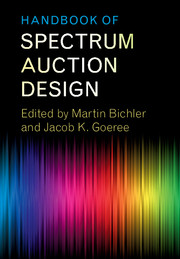Book contents
- Frontmatter
- Contents
- List of Contributors
- Preface
- List of Papers
- Part I The Simultaneous Multiple-Round Auction
- Part II The Combinatorial Clock Auction Designs
- 5 Combinatorial Auction Design
- 6 The Clock-Proxy Auction: A Practical Combinatorial Auction Design
- 7 Spectrum Auction Design
- 8 A Practical Guide to the Combinatorial Clock Auction
- 9 Market Design and the Evolution of the Combinatorial Clock Auction
- 10 Quadratic Core-Selecting Payment Rules for Combinatorial Auctions
- 11 Core-Selecting Package Auctions
- 12 A New Payment Rule for Core-Selecting Package Auctions
- 13 On the Impossibility of Core-Selecting Auctions
- 14 Ascending Combinatorial Auctions with Risk Averse Bidders
- 15 Properties of the Combinatorial Clock Auction
- 16 Budget Constraints in Combinatorial Clock Auctions
- 17 (Un)expected Bidder Behavior in Spectrum Auctions: About Inconsistent Bidding and its Impact on Efficiency in the Combinatorial Clock Auction
- Part III Alternative Auction Designs
- Part IV Experimental Comparisons of Auction Designs
- Part V The Bidders’ Perspective
- Part VI Secondary Markets and Exchanges
- Outlook
- References
15 - Properties of the Combinatorial Clock Auction
from Part II - The Combinatorial Clock Auction Designs
Published online by Cambridge University Press: 26 October 2017
- Frontmatter
- Contents
- List of Contributors
- Preface
- List of Papers
- Part I The Simultaneous Multiple-Round Auction
- Part II The Combinatorial Clock Auction Designs
- 5 Combinatorial Auction Design
- 6 The Clock-Proxy Auction: A Practical Combinatorial Auction Design
- 7 Spectrum Auction Design
- 8 A Practical Guide to the Combinatorial Clock Auction
- 9 Market Design and the Evolution of the Combinatorial Clock Auction
- 10 Quadratic Core-Selecting Payment Rules for Combinatorial Auctions
- 11 Core-Selecting Package Auctions
- 12 A New Payment Rule for Core-Selecting Package Auctions
- 13 On the Impossibility of Core-Selecting Auctions
- 14 Ascending Combinatorial Auctions with Risk Averse Bidders
- 15 Properties of the Combinatorial Clock Auction
- 16 Budget Constraints in Combinatorial Clock Auctions
- 17 (Un)expected Bidder Behavior in Spectrum Auctions: About Inconsistent Bidding and its Impact on Efficiency in the Combinatorial Clock Auction
- Part III Alternative Auction Designs
- Part IV Experimental Comparisons of Auction Designs
- Part V The Bidders’ Perspective
- Part VI Secondary Markets and Exchanges
- Outlook
- References
Summary
In this paper we study some properties of a new auction design, the combinatorial clock auction (or CCA). The CCA was proposed by Ausubel, Cramton and Milgrom (2006). It is essentially a dynamic Vickrey auction. The Vickrey auction is central to economic theory as the unique auction that provides truthful incentives while achieving an efficient allocation. Yet it is often viewed as impractical for real-world applications because it requires bidders to submit bids for many possible packages of items. Economists think of dynamic auctions as having an advantage in this regard because bidders can discover gradually how their demands fit together — what Paul Milgrom has called the “package discovery” problem.
The CCA combines an initial clock phase, during which prices rise and bidders state their demands in response to the current prices, with a final round in which bidders submit sealed package bids. The seller uses the final bids to compute the highest value allocation and the corresponding Vickrey payments. Ideally, bidders demand their most desired package at every stated price in the clock phase, allowing for information revelation. Then in the final round, they bid their true preferences, leading to an efficient allocation with truthfulVickrey prices. The question we address is whether this is the likely equilibrium outcome of the CCA; that is, whether the desirable incentive properties of the Vickrey auction are retained.
The practical motivation for our study is the recent and widespread adoption of CCA bidding to sell radio spectrum licenses. Spectrum auctions have provided the motivation for some important recent innovations in auction design, starting with the simultaneous ascending auction pioneered by the FCC in the early 1990s and subsequently adopted in many other countries (Klemperer, 2004; Milgrom, 2004). The FCC design allows for gradual information revelation, but it does not easily accommodate package bidding, and it creates incentives for demand reduction because winners pay their bids (Cramton, 2013). In principle, the CCA addresses both of these issues.
- Type
- Chapter
- Information
- Handbook of Spectrum Auction Design , pp. 294 - 317Publisher: Cambridge University PressPrint publication year: 2017



